Dr Liz Rylott
Senior Lecturer
Research
Research
Using plants to recover metals from contaminated land
Large areas of land are contaminated with toxic levels of metals from industrial pollution, and also from naturally occurring geological deposits. This pollution prevents the land from being used for agriculture and is a source of toxicity directly, and via accumulation in food chains.
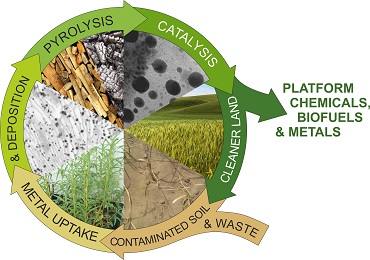
Using plants to remediate metal contamination and deliver value added products
Metals such as rare earth elements, platinum group metals and precious metals such as gold, silver and nickel are used in an increasing number of biotechnological applications, with suitable substitutes lacking, global reserves depleting and existing reserves vulnerable to geopolitically-controlled supply restrictions. Yet, despite these factors, and the high environmental impacts of extraction, after use metals are often dispersed and diluted back into the environment. One way to recapture them, while revegetating, detoxifying and stabilising contaminated areas, is through phytomining: the use of plants to take up, and concentrate metals.

Gold nanoparticles in Transmission Electron Micrographs of Arabidopsis leaves
Using plants to extract metals from the environment is not a new idea, but the costs of growing, harvesting and transporting metal-rich plant biomass, in addition to the cost of smelting to the base metal, have been prohibitive to the development of metal phytoextraction. Our research uses biology to understand the mechanisms behind metal uptake and storage, and apply this knowledge to improve metal specificity, develop value-added products from metal-rich biomass, and recover metals for reuse. We have shown that plants can take-up, and deposit, palladium and gold as nanoparticles with in vivo catalytic activity. Our research is now discovering how nickel-rich, pyrolysed plant biomass can be used to catalyse the conversion of the surrounding plant biomass into platform molecules for biofuels, and to breakdown some plastics into their monomer components for recycling.
How plants detoxify pharmaceuticals in waste streams
With nearly 350,000 different man-made chemicals in use globally, the environment is under increasing threats from their toxicity. This threat is especially true of the agroecosystem where soil amendment with biosolids and wastewater reuse for irrigation are increasingly used practices in crop production globally. However, these wastes are known reservoirs for complex chemical mixtures that enter sewage systems after human or industrial use. Plant food crops are known to take up these chemicals presenting the possibility of a circular route to human exposure via ingestion.
Plants have evolved a magnificent array of biochemical pathways that can detoxify many thousands of different chemicals. We use state-of-the-art techniques to identify in-planta metabolites, and identify and characterise key xenobiotic-detoxifying enzymes.
Phytoremediation of explosives
Perhaps it is surprising to know that explosives are major environmental pollutants, yet in the U.S. alone, over 10 million hectares of military land is contaminated with munitions components. These compounds are toxic and extremely resistant to degradation in the environment; there are explosives still present in our environment that date back to WWI and WWII.
The major explosives are 2,4,6-trinitrotoluene (TNT) and hexahydro-1,3,5-trinitro-1,3,5-triazine (RDX). Given the scale of the problem, using plants to clean up this pollution seems like a good idea. But this approach is hindered by the toxicity of these compounds and the inability of plants to breakdown them down. However, microbes have evolved clever ways to metabolise explosives.
By isolating microbes from soil contaminated with explosives, we have identified the genes and characterised the unique biochemistry behind this process. Using biotechnology-based approaches, we have developed plants able to detoxify explosives, with GM switchgrass now under trials on in the U.S. The knowledge we have gained using RDX and TNT as exemplar organic pollutants is paving the way for the development of remediation strategies for organic pollutants globally.
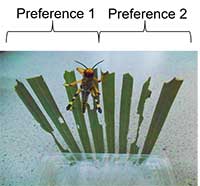 Locust feeding preference tests - can they taste GM? |
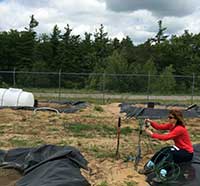 Setting up lysimeters on RDX-degrading GM grasses field trial |
 Outreach model explaining research in Johnson et al Science 349 pp1072 |
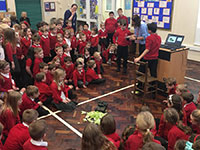 Driving a tank over lettuce at Dringhouses primary school. Credit: Dringhouses Primary School |
York Environmental Sustainability Institute (YESI)
Liz also works with YESI as a Research Theme co-lead focused on Food, Water & Waste.
Teaching and scholarship
Teaching and scholarship
![]() The opportunity to teach someone is a wonderful thing. There are so many exciting bits of science out there, and this is just the tip of our knowledge iceberg. Enthusing students with new scientific breakthroughs, as well as established, elegant fundamentals, are glorious things to do.
The opportunity to teach someone is a wonderful thing. There are so many exciting bits of science out there, and this is just the tip of our knowledge iceberg. Enthusing students with new scientific breakthroughs, as well as established, elegant fundamentals, are glorious things to do.
![]() My lectures are focused on my research interests: plant science and biotechnology. Fundamental concepts such as the Proton Motive Force, the ‘batteries of life’, are literally what get me out of bed in the morning. Photosynthesis, a remarkable process, supplies pretty much all the energy needed for life on earth. There are many gallant and necessary endeavours to find cures for human disease, but plants, via photosynthesis, are what grows a human in the first place. Plants rock.
My lectures are focused on my research interests: plant science and biotechnology. Fundamental concepts such as the Proton Motive Force, the ‘batteries of life’, are literally what get me out of bed in the morning. Photosynthesis, a remarkable process, supplies pretty much all the energy needed for life on earth. There are many gallant and necessary endeavours to find cures for human disease, but plants, via photosynthesis, are what grows a human in the first place. Plants rock.
![]()
I relish the chance to encourage, inspire and mentor people in tutorials. My tutorials are designed to complement lectures and practical. A chance for students to work on their presentation and debating skills, hone experimental design, understand the, sometimes quirky, rules of scientific writing and how to critique a scientific paper. We’ll focus predominantly on my research area of plant biotechnology, exploring how plants can be used to clean up environmental pollutants, but can cover other areas of science too. These tutorials come with plenty of support, feedback, laughs and the occasional biscuit.
![]()
The projects I run are mostly laboratory based, but there are science communication projects too. The projects are designed to fit in with on-going research projects, and take place within the CNAP laboratories; cutting-edge, working research labs. You’ll get to work alongside real researchers, learn key techniques in molecular biology and related methodologies, with plenty of opportunities to discuss and present your science with experts. The projects will use plants or microbes to help develop technologies to address some of the grand challenges facing humanity. And all within a friendly, experienced and supportive group of postdoctoral researchers and technicians and some of your peers.
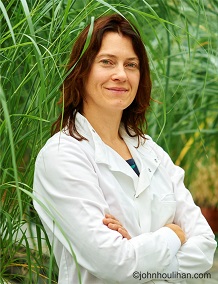
Contact details
Centre for Novel Agricultural Products
@LizRylott
